A great trail horse has no problem walking confidently through water—no matter how small or large the body of water is.
Whether it’s a puddle or a creek, water crossings can turn into all-out battles with some horses. But you can take the worry out of water with a step-by-step, commonsense approach.
When you consider what you’re asking your horse to do at a water crossing, it’s little wonder that most horses put up a fight when you first ask them to get their feet wet. Horses are naturally frightened of objects that move and make a noise. When a horse steps into water, it not only moves, it also makes a noise. That’s why, when you urge your horse to walk through water, he may behave like you’re trying to drown him for the insurance money.
Like with every other obstacle, it’s best to introduce water crossings to your horse from the ground and to start with a low-key version of the obstacle so as not to overwhelm your horse. Then, as your horse’s confidence grows, you’ll move from the ground to the saddle, and increase the size and depth of the body of water you ask him to cross.
Ground Rules
The best piece of advice I can give you about water crossings is this: If you want to teach your horse to cross water, don’t start with the ocean if he can’t handle a puddle. That may sound like plain old common sense, but you wouldn’t believe the number of people who try to get their horses to step into a pond when they won’t even cross through a small puddle. Before heading out onto the trail and coming across a water obstacle your horse can’t handle, practice at home first, starting with groundwork.
Find a puddle to work with or you can easily make one yourself by letting the hose run for a bit in the arena or on a dirt path. Then, establish a starting point—a place where your horse is comfortable being next to the puddle—that may be 10 or 15 feet away from it. Keep in mind that how far away you start from the puddle will depend on how scared your horse is of it. If he’s really frightened of water, you may even have to start 50 feet away from it.
Once you’ve established your starting point, begin to send your horse between you and the puddle using the Sending Exercise. As the horse’s confidence grows, gradually work your way closer to the puddle. Before moving on to the next step, your horse should be confidently going past the puddle in a relaxed manner on all sides of it. If he’s tossing his head and rushing by the puddle, he’s just telling you that you need to spend more time building his confidence.


Using the Sending Exercise, send the horse back and forth in front of the puddle. As his confidence grows, he’ll gradually get closer to the water.
The more you retreat, the more you act like you don’t want him to go into the water. Eventually, your horse will take one step in the water. Then he’ll take two, etc. Keep approaching and retreating until your horse can step into the puddle and back out of it.
When your horse is comfortable about getting his feet wet, you can walk him through the puddle using the Sending Exercise. Try to keep your feet as still as possible and send your horse into the puddle. Remember, the less you move your feet, the more control you have of your horse.
If your horse braces his feet at the edge of the puddle, back him up a few steps and then ask him to come forward again. Don’t try to force him to step into the water—it has to be his idea. Think of it like a game of cat-and-mouse. The more you act like you want your horse to get into the water, the more he’ll resist your efforts. Act like you couldn’t care less whether he steps in the water, and before long, he’ll be walking through it with confidence.
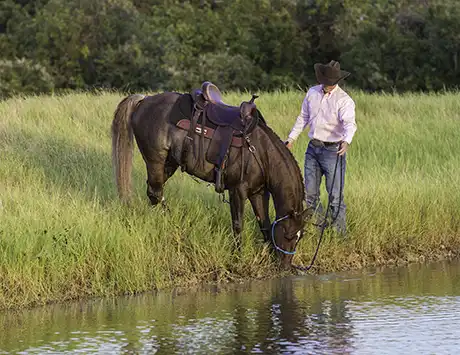
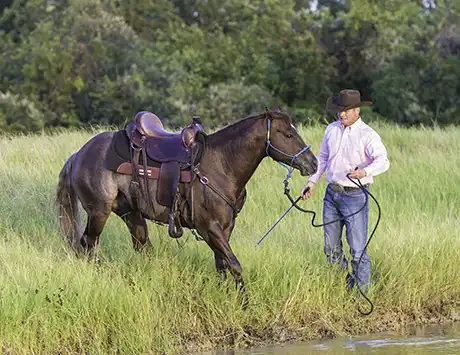
The key to using Approach and Retreat is to stop the horse and back him away from the obstacle before he decides to stop on his own.
When your horse is confidently passing between you and the puddle, start asking him to step into the water by using the Approach and Retreat Method. Walk your horse up to the water. If you think he’s going to balk and stop 15 steps away from the puddle, stop him in 14. Then back him away from the water. You’re going to go forwards and backwards—almost like a yo-yo. Go forward again, and before he stops, stop him and back him up. The trick to using Approach and Retreat is to stop your horse and back him away from the puddle before he stops himself. That way, stopping is always your idea.
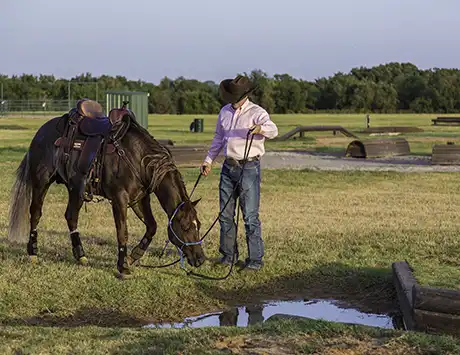
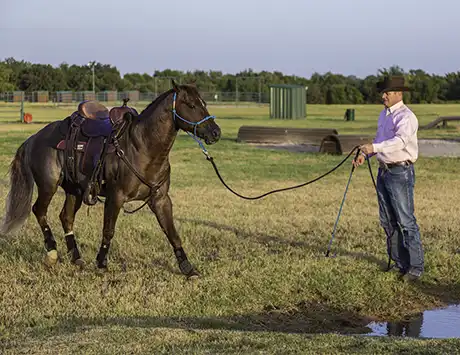
Think of Approach and Retreat like a game of cat-and-mouse. The more you say, “Get away from that water,” the more the horse will want to get to it.
With that being said, there are some horses out there that’ll get smart and realize that if they act scared of the water, they’ll get to rest at the edge of it all day long. They’re not really scared of the water; they’re just lazy. So with these horses, you need to add a little bit of pressure and encouragement to make them step into the water. When the horse is confident about walking through a puddle of water, move on to a bigger challenge. You may go from a puddle to a small stream to a pond and so on. No matter the size of the body of water you’re asking the horse to cross, the same training principles apply. You’ll begin by sending the horse between you and the water and then ask him to step in it. If you can’t get control of the horse’s feet near the water, you will never be able to control them in the water. Rather than doing the Sending Exercise into and out of the water, when you start working with a large body of water like a pond, you can use Lunging for Respect Stage Two to keep the horse’s feet moving in and around the obstacle. When working with a larger body of water, most horses will get their feet wet and then jump out. Be ready for this. Keep your Handy Stick in front of you and be aware of what the horse is doing so you don’t get jumped on. Continue asking the horse to step into the water until he no longer gets uptight about getting his feet wet.

When asking the horse to step into a larger body of water, you’ll use the same approach: Practice the Sending Exercise along the water’s edge, gradually getting closer to it until the horse steps into the water.
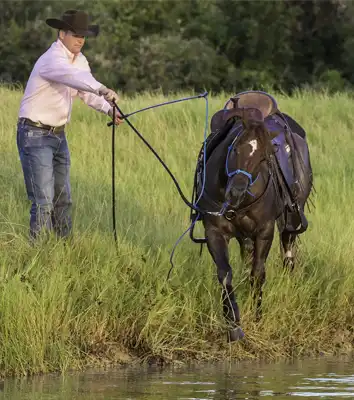
If the horse tries to push into your space, tap him away from you using your Handy Stick.
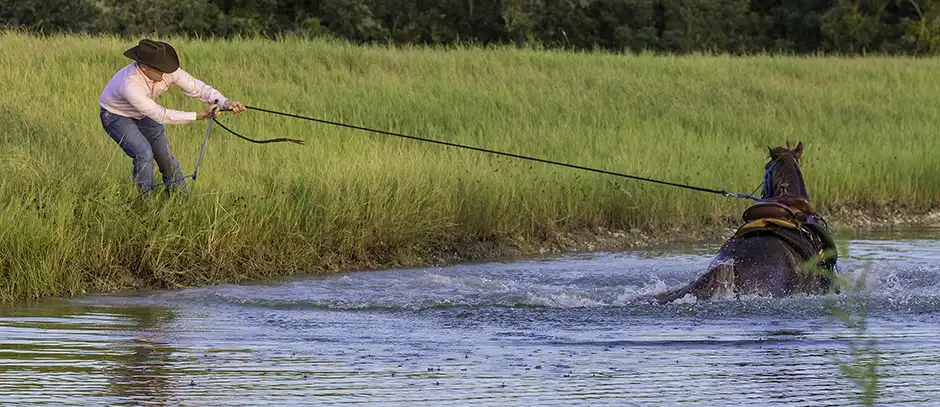
Be aware that some horses will try to run into large bodies of water. If your horse does that, don’t get dragged in behind him!
Some horses, once they get their feet wet, will try to plunge farther into the water. If this happens, bump on the horse’s halter until you get his attention. Don’t make a big deal of correcting him for this behavior so that he feels wrong for going into the water, but at the same time you want to stop him from going farther in. On the one hand, you appreciate the effort he is making, using the thinking side of his brain and jumping in. On the other hand, there is no need for you to get pulled along into the pond behind him!
Once the horse is comfortable walking through the water, one of the best ways you can build his confidence about the obstacle is to rest him in the water. Hustle his feet on the shore—do some Lunging for Respect Stage Two, backing exercises, etc.—and then let him rest in the water. If he tries to walk out of the water before you ask him to, let him get to the shore and immediately put his feet to work. Then go rest him in the water again. Before long, the horse will associate water with resting and will happily rest in it.
Under Saddle
Once your horse is calmly walking through water with you on the ground, you’re ready to tackle the obstacle from the saddle. Since you’ve prepared your horse from the ground first, getting him to cross the water while you’re on his back shouldn’t be a big deal. Just like when you worked with your horse on the ground, the first thing you’ll do once you get in the saddle is establish a starting point. How close you can initially get your horse to the puddle depends on how fearful he is of it. If you’ve prepared him with groundwork, you should be able to get him pretty close to the puddle.
Even if you’ve worked your horse in a larger body of water from the ground, I recommend going back to a puddle when you initially approach this obstacle from under saddle. Any time you change an element with a horse, no matter how minute, it’s a completely new experience for him.
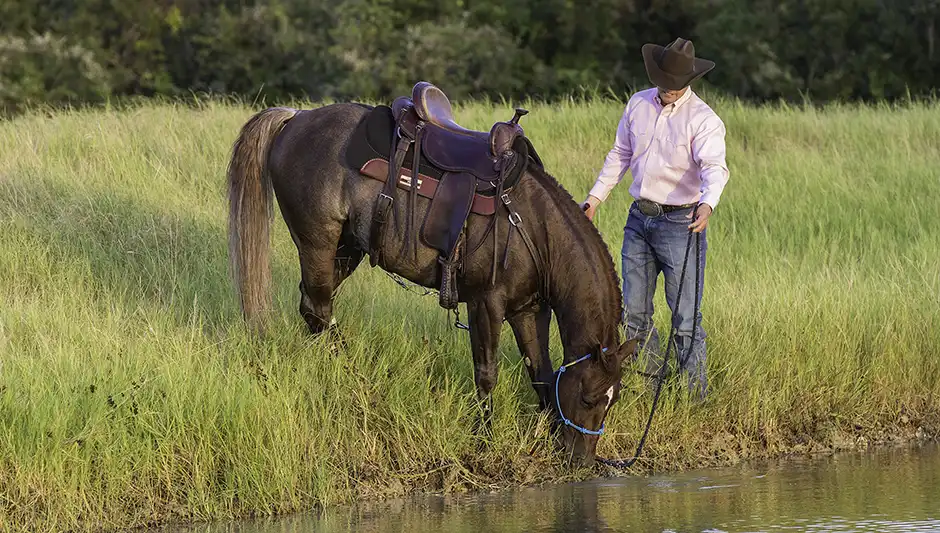
Introducing a horse to water after a training session, when he’s hot and thirsty, will make the water more inviting to him.
Redirect Those Feet
Once you’ve established a starting point, begin to trot a circle around the puddle, being sure to keep your horse’s feet moving with energy. Every one-and-a-half circles, turn your horse 180 degrees in toward the puddle and circle around the puddle in the opposite direction.
Whenever a horse is frightened of something, he uses the reactive side of his brain. When a horse uses the reactive side of his brain, he’s nervous, full of energy, hyper and not paying any attention to his rider. Whenever you’re around your horse, you want him to use the thinking side of his brain—the calm, analytical, safe and attentive side.
In order to get a horse to use the thinking side of his brain, redirect his feet. If you’re constantly stopping and redirecting his feet, your horse won’t have time to be scared of the object and pay attention to you at the same time. Instead, he can only pay attention to one thing at a time, and since you’re the one moving his feet, he’ll pay attention to you.
Keep in mind that you don’t want to let him walk around the puddle, just plodding along. Get some energy in his feet and hustle him around the puddle. If you’re circling to the right, use your right rein and left leg to ask your horse to roll back to the right. By turning your horse in toward the puddle, you’re gradually getting him closer to the water every time you turn him. And eventually, he’ll step into the water without even meaning to.
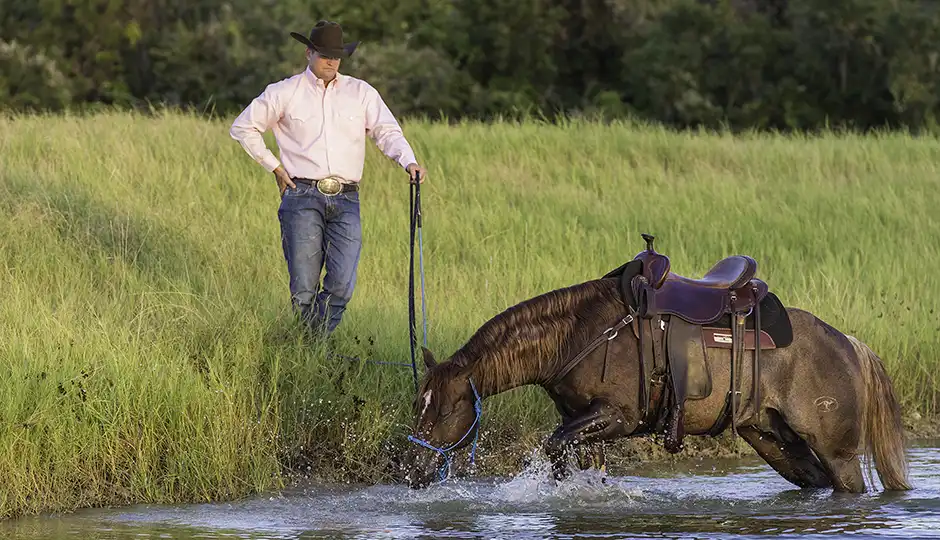
When the horse gets into the water, let him paw it, take a drink, etc. The more he plays in the water and realizes it won’t harm him, the more confident he’ll get about it.
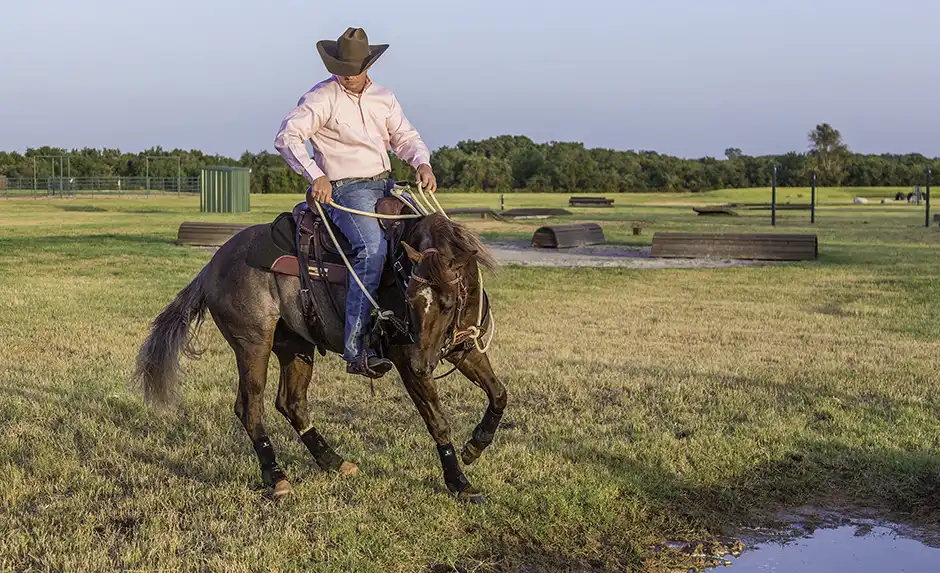
Horses can only pay attention to one thing at a time. If you’re asking your horse to hustle his feet and change directions, he can’t focus on his fear of the water.
Use His Fear to Your Advantage
When a horse is frightened of something, his instinct is to get away from whatever is scaring him. In this situation, you’ll use that fear to your advantage. The more fearful your horse is, the more he’ll suck back and want to get away from the water. That fear will cause him to really sit back on his haunches as you roll him back, which helps to improve the maneuver. So as long as he wants to suck back, use that in a positive way.
The most important thing to keep in mind is to always keep your horse’s feet moving. The more you make him move his feet and change directions, the more he’ll use the thinking side of his brain and pay attention to you instead of focusing on his fear of the water. You’re just saying, “Hey, listen, what a coincidence. We happen to be practicing circles and turns around this puddle. What are the odds of that?”
When most riders approach a water crossing, they walk the horse straight up to it and try to force him to step into the water. The more you force a horse to walk straight up to an object he’s scared of, the more frightened he gets. That’s a very direct line approach—a predator act. Whenever you start to act like a predator, your horse will automatically start to act like a prey animal. He’ll want to back away from the puddle, run around the side of the puddle, rear up, shake his head, and do all those other silly things that we don’t want him to do.
A rollback is a physically demanding maneuver for a horse to do when he does it correctly. Eventually, as you circle the puddle and roll back into it, the horse will get lazier and stop putting in as much effort, which will cause him to get closer and closer to the puddle until one of his hooves steps in the water. Every time he steps in the water and doesn’t get killed, he realizes that he can be a little more confident. The next time you turn him, he might take two steps into the puddle, but he doesn’t have to panic because you’ll turn him right back out of the water again. Go around the other way. Then turn again. Now he takes three steps into the water. Eventually, he’ll get a little lazier so that when you turn, instead of doing a stop and a rollback, he’ll actually cut through the center of the puddle.
When he cuts through the center, go through to the other side of the puddle and circle him around the other way. Keep taking him back through the middle of the puddle. But you’re doing it in a real casual way. Just act like, “Hey, I’m just practicing figure 8s. And what do you know? A puddle just happens to be smack bang in the middle of this figure 8.”
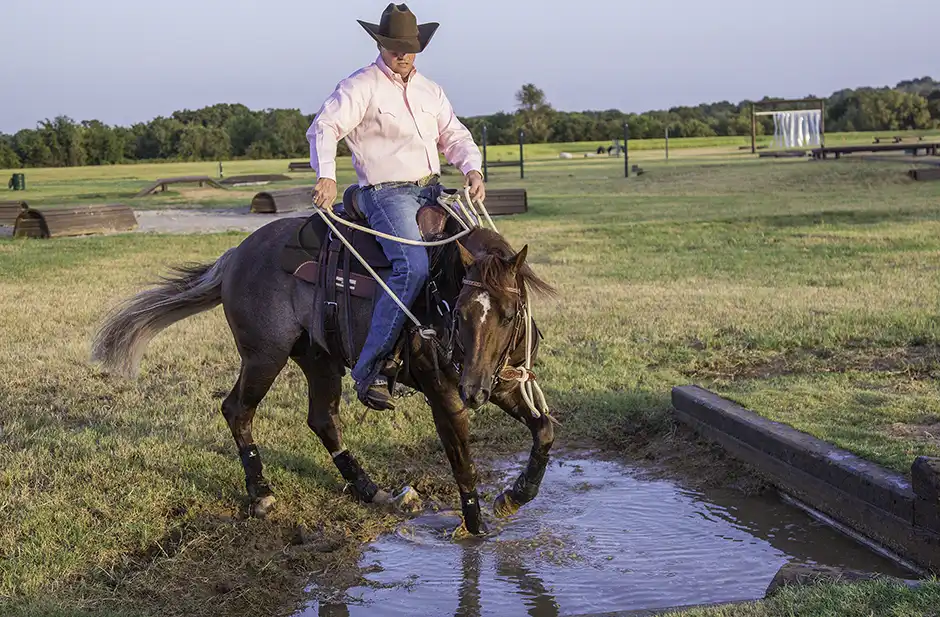
Before long, the horse will get a little lazy with the rollbacks and will eventually take a step or two into the water.

If the horse rushes through the water, once he gets to the other side, put his feet to work by bending him in a few circles.
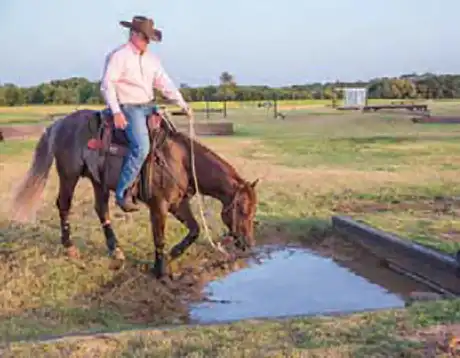
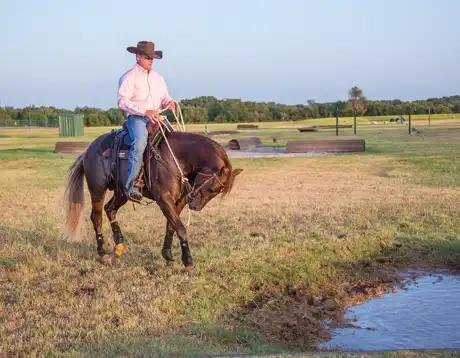
Just as on the ground, back the horse away from the water before he stops on his own.
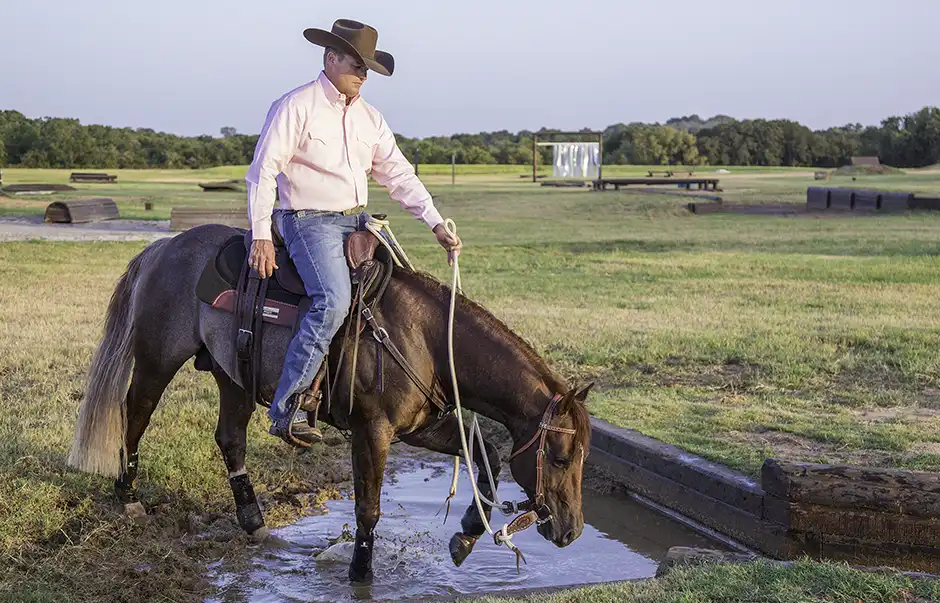
Your goal is to have the horse walk confidently and calmly through the puddle of water.
Once your horse is moving calmly through the water, let him stop and investigate it. If he wants to paw or drink from it, let him. Allowing your horse to perform his own “safety check” is a great way to build his confidence. Every time the water touches him and he doesn’t get hurt, he gains more confidence. Once he’s performed his safety check, continue to ask him to cross in and out of the water at the walk until he’s relaxed and confident. You may have to cross in and out of the water 10 times, or you may have to do it 100 times. Do whatever it takes to build the horse’s confidence.
The secret is to not let your horse know you want him in the water. The more you act like you’re trying to get him into the water, the more he thinks you’re trying to kill him for the insurance money. Instead, turn it into a game of cat-and-mouse.
The Approach and Retreat Method will take longer than circling the water and rolling back into it, but if you don’t have the environment to circle the water safely, you’ll have to do what you can with what you have. That’s why it would be a smart idea to introduce your horse to a water obstacle in a controlled environment, where you’re able to introduce it to him in the best way possible. Increase the Challenge Once you’ve conquered the puddle, you’re ready to try something more challenging, such as a small stream or pond and eventually a large lake. You’ll use the exact same plan of attack as described above, always establishing a starting point and gradually building your horse’s confidence. Remember, even though your horse was confidently stepping through the puddle, he might lose his confidence when confronted with a larger body of water. When you ask your horse to step into a large body of water, such as a lake that you can’t circle around, you can trot a straight line on the shore and roll back into the lake. Initially, you might not be able to get the horse close to the water, but with each rollback, you’ll gradually get him closer to the water. Eventually, he’ll place one foot in the water, then two, and before long he’ll be confidently walking through it. If you don’t act like a predator, trying to force him into the water, and instead redirect his feet to get him using the thinking side of his brain, your horse will cross through any body of water confidently in no time.
Increase the Challenge
Once you’ve conquered the puddle, you’re ready to try something more challenging, such as a small stream or pond and eventually a large lake. You’ll use the exact same plan of attack as described above, always establishing a starting point and gradually building your horse’s confidence. Remember, even though your horse was confidently stepping through the puddle, he might lose his confidence when confronted with a larger body of water.
When you ask your horse to step into a large body of water, such as a lake that you can’t circle around, you can trot a straight line on the shore and roll back into the lake. Initially, you might not be able to get the horse close to the water, but with each rollback, you’ll gradually get him closer to the water. Eventually, he’ll place one foot in the water, then two, and before long he’ll be confidently walking through it. If you don’t act like a predator, trying to force him into the water, and instead redirect his feet to get him using the thinking side of his brain, your horse will cross through any body of water confidently in no time.
Practice Makes Perfect
The key to teaching your horse to navigate any obstacle, including water, is to give him enough practice so that he gains confidence. Go over a stream or through a pond a hundred times. Go over it again and again, from different angles, at different speeds, and from all sides. At the ranch, we end every horse’s training session by putting him on a big, loose rein and letting him walk in the shallow perimeter of one of the ponds on the property. At that point in the ride, the horse is sweaty and he’s a little tired. Splashing through water doesn’t sound like a bad deal to him. If the horse wants to stop and drink water, we let him. If he wants to stop and stand for a few minutes, we let him. We rub on him and don’t make him feel wrong for relaxing. We make the pond seem like the best part of the ride for the horse, and it doesn’t take long for him to look forward to getting his feet wet.
When There’s No Room to Circle
When you’re on the trail, if you come to a water crossing in which there is no room to circle your horse around the water and roll him back into it, use Approach and Retreat. Encourage your horse to approach the water as close as he will get to it without having to be forced. At whatever point that is, stop him and then back him away from the water. Continue to approach and retreat, encouraging the horse to get a bit closer to the water with each approach. When your horse eventually steps in the water with a front foot, don’t push him any farther; instead, retreat. Back him out of the water. Next time you ride him up to the water, he’ll put both of his front feet in the water, and you’ll back him out of it. With repetition, the horse will calmly walk through the water.
If you’re smart, when you get to the other side of the water, you’ll walk him back through the water again, and you’ll continue to walk back and forth through the water until there’s no doubt in your mind that your horse is confident about crossing through the water.
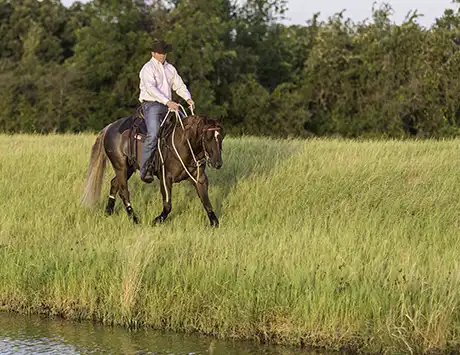
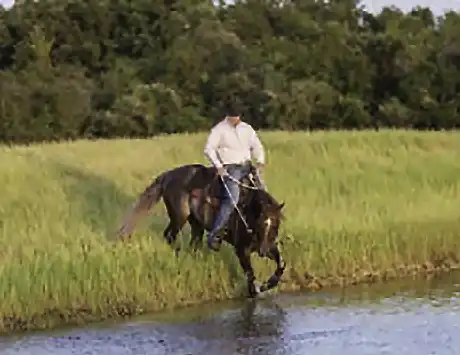
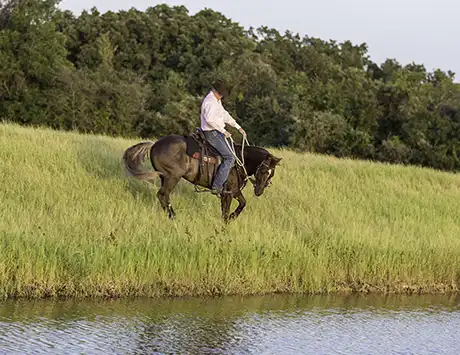

When approaching a large body of water, trot the horse in a straight line along its bank. Then ask the horse to stop and turn in toward the water and trot off in the new direction. Each time you turn the horse into the water, he’ll get closer to it until he eventually steps in it. If you’re consistent, the horse will confidently walk through the water.
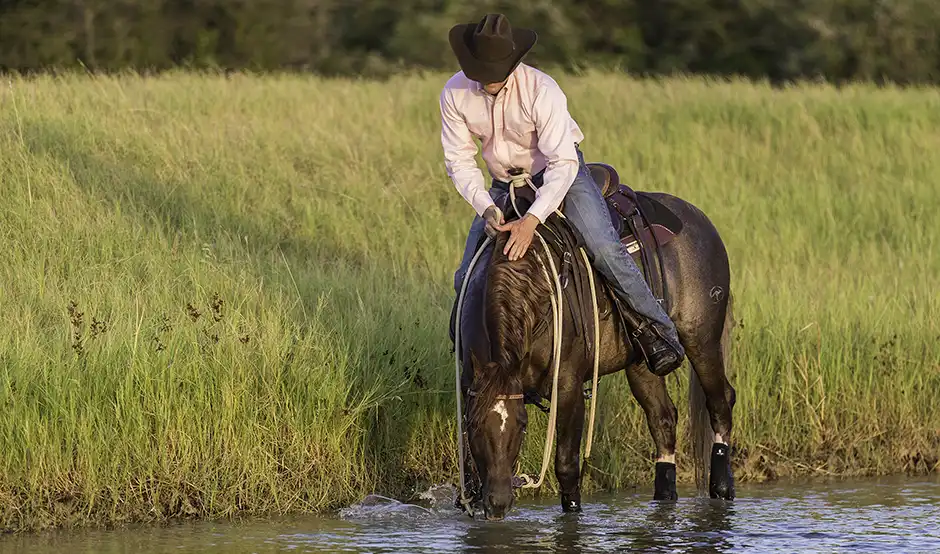
We teach our horses to crave water at the ranch by letting them rest in a pond at the end of training sessions.
You can teach your horse to crave getting in water, too, even if you don’t have a pond on your property. Hustle the horse’s feet on the shoreline, constantly asking him to change directions so that he works up a bit of sweat, then offer him the chance to rest and relax in the water. After letting him rest in the water for five minutes, take him back to the shoreline and hustle his feet. It’s the same concept we use when trailer loading a horse: It’s hard work outside the trailer and rest and reward inside the trailer. The bottom line is horses learn by doing, so let your horse do water. Spend the time to teach him that water is nothing to fear and how to go through it. Then, when you encounter any water hazard on the trail, he will be able to cross it with ease. Repetition, repetition, repetition!
Confronting Mud
If you find yourself riding on a post-rainstorm trail, you’re likely to come across patches of mud. Because your horse’s eyesight gives him poor depth perception, he’ll probably view the mud as a black hole you’re asking him to step in. Not only that, but depending on the type of dirt the trail is made up of and the condition of the ground, the mud could be thick and make loud sucking sounds as your horse steps through it. Remember, horses hate objects that move and make a noise, so a muddy spot on the trail is likely to fire up the reactive side of his brain. You’ll use the exact same steps that you used with water to get your horse through mud and teach him to calmly negotiate it, using the thinking side of his brain. Because mud can be slick or quickly get that way as you ride your horse through it, be aware of the condition of the ground and what you’re asking the horse to do. Instead of trotting him in circles and rolling him back into the mud, you may have to slow down to the walk. Use common sense. Just like water crossings, practice going back and forth through the mud until the horse is using the thinking side of his brain and walking calmly through it. If he rushes through it, bend him around in circles on each side and then send him back through again.

When it comes to riding your horse through water, use your head. Don’t ask your horse to cross anything that’s unsafe and could get the two of you injured.

Master Your horsemanship Skills
Like these tips? Join the No Worries Club and hone your skills with thousands of hours of Clinton’s easy, step-by-step method horse training videos.



